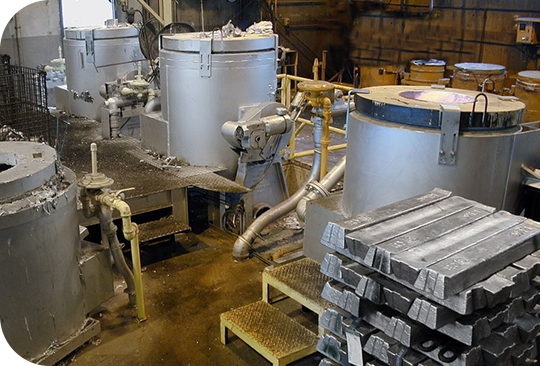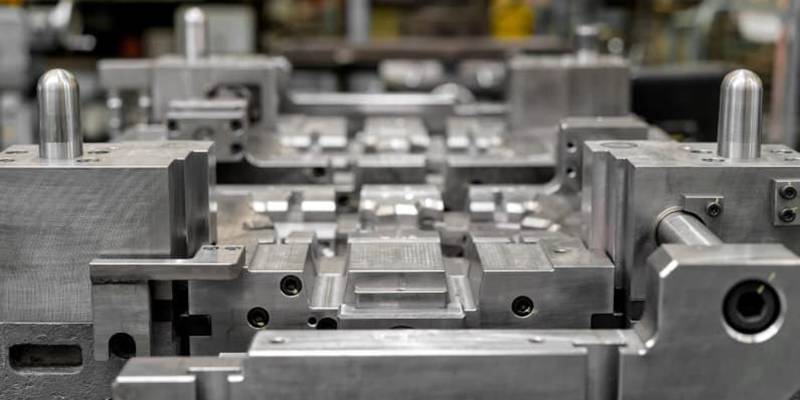The ultimate checklist for Aluminum Casting projects
Comprehending the Advantages and Ranges of Aluminum Castings in Industry
Aluminum castings have ended up being significantly crucial throughout different sectors because of their one-of-a-kind homes and manufacturing flexibility. Their light-weight and corrosion-resistant nature makes them appropriate for demanding applications. Different spreading approaches allow for precise and detailed layouts. As industries progress, comprehending the range of light weight aluminum spreading options and their benefits is vital. This exploration raises questions regarding their future function in production and sustainability. What exists in advance for light weight aluminum in these fields?
The Fundamentals of Aluminum Casting Processes
Although aluminum casting procedures vary in method, they all share an usual goal: to transform liquified aluminum into precise shapes and parts. The key techniques of light weight aluminum spreading consist of sand casting, die spreading, and financial investment casting. In sand casting, mold and mildews are created utilizing sand, enabling elaborate styles yet usually resulting in a harsh surface area coating. Die casting employs high-pressure shot of liquified aluminum right into steel mold and mildews, generating high precision and smooth surface areas, appropriate for mass manufacturing. Financial investment spreading, or lost-wax casting, involves producing a wax pattern coated with a ceramic shell, supplying phenomenal detail and dimensional accuracy. Each technique has its specific applications and considerations, including cost, production quantity, and complexity of the forms created. Understanding these fundamental techniques is important for markets that rely on light weight aluminum castings to fulfill their style and useful requirements.
Key Benefits of Using Aluminum Castings
Aluminum castings use numerous advantages that make them a favored choice in various markets. One of the essential advantages is their lightweight nature, which allows for much easier handling and minimized delivery prices. This particular adds to improved energy effectiveness, specifically in auto and aerospace applications. Furthermore, light weight aluminum exhibits superb corrosion resistance, expanding the lifespan of elements and lessening maintenance requirements.
Another benefit is the versatility of aluminum castings, which can be built into intricate forms, enabling innovative designs that conventional products might not accommodate. The thermal and electrical conductivity of aluminum likewise makes it ideal for applications requiring heat dissipation or reliable electric links. Aluminum castings are recyclable, aligning with sustainability objectives and minimizing environmental effect. On the whole, the mix of toughness, longevity, and flexibility makes light weight aluminum castings a vital element in modern-day manufacturing techniques throughout several fields.
Typical Sorts Of Aluminum Castings
Aluminum castings are produced with different approaches, each fit for various applications and demands. Among one of the most typical strategies are sand casting, which offers versatility and cost-effectiveness, and die casting, known for its accuracy and efficiency. Comprehending these procedures is essential for picking the appropriate spreading approach for particular industrial requirements.
Sand Casting Process
A considerable section of light weight aluminum castings in industry is generated via the sand casting process, which is renowned for its convenience and cost-effectiveness. This technique involves producing a mold and mildew from a sand mixture, allowing for the manufacturing of complex shapes and large elements. Sand spreading is particularly useful for small to medium-sized production runs, as it requires very little initial financial investment in tooling. The procedure starts with pattern making, followed by mold preparation, putting liquified aluminum, and ultimately, cooling and ending up. The high thermal conductivity of aluminum warranties even cooling, reducing the risk of problems. Sand casting remains a recommended selection for producers seeking performance and adaptability in their light weight aluminum casting applications.
Die Casting Techniques
Die casting techniques represent an extremely effective method for producing light weight aluminum castings, specifically fit for high-volume production. These strategies mostly consist of 2 common kinds: hot chamber and chilly chamber die casting. In hot chamber die spreading, the liquified aluminum is infused into the mold from a storage tank that is warmed, making it optimal for low-melting-point alloys. Conversely, cool chamber die casting entails pouring the liquified aluminum right into a separate chamber before injection, which suits higher melting-point products. Both approaches supply precision in shaping complicated geometries and achieving superb surface area finishes. Additionally, pass away spreading is known for its quick cycle times, lowering production costs while keeping consistency in quality throughout large amounts of components.
Applications in the Automotive Market
Transforming lorry layout and efficiency, light weight aluminum castings play an essential duty in the vehicle industry. These castings add substantially to weight reduction, boosting fuel efficiency and general lorry dynamics. Trick applications consist of engine blocks, transmission housings, and suspension elements, where their lightweight nature and stamina are essential.
Aluminum castings additionally permit for complicated geometries, allowing suppliers to create detailed designs that maximize air movement and lower drag. investigate this site This capacity is especially useful in electric and hybrid cars, where performance and efficiency are paramount.
In addition, the rust resistance of aluminum expands the lifespan of automobile parts, reducing maintenance prices and enhancing lorry dependability. The versatility of aluminum castings sustains both mass production and custom applications, making them a recommended choice among automotive engineers and developers. Aluminum Casting. As the industry remains to introduce, light weight aluminum castings will remain a vital aspect in the search of sophisticated auto technologies
Aerospace Sector Utilization
In the aerospace sector, aluminum castings are integral to the design and performance of aircraft parts. These castings are used in different applications, including engine components, structural parts, and indoor fittings. Their lightweight nature adds to improved fuel efficiency and total efficiency, which is necessary in aerospace engineering.
Aluminum castings likewise provide superb strength-to-weight ratios, allowing producers to create detailed designs without compromising architectural integrity. The ability to produce intricate geometries makes light weight aluminum casting a recommended option for elements that call for precision and reliability.
In addition, light weight aluminum's resistance to rust improves the longevity of aerospace parts, minimizing maintenance prices and boosting safety (Aluminum Casting). The casting procedure enables high-volume production, satisfying the sector's demands for performance. On the whole, aluminum castings play a critical duty ahead of time aerospace modern technology and maximizing airplane layout, adding to the industry's recurring innovations

Advantages Over Other Materials
Aluminum castings supply substantial benefits over various other products, making them a preferred choice in different industries. Among the main benefits is their light-weight nature, which adds to reduced power consumption and boosted performance in applications such as auto and aerospace. Additionally, light weight aluminum displays exceptional corrosion resistance, enabling prolonged sturdiness and lowered upkeep costs.
The material's premium thermal and electrical conductivity even more improves its charm, especially in applications requiring warmth dissipation or efficient energy transfer. Aluminum Casting. Aluminum castings likewise provide excellent dimensional security, making sure specific resistances and lowering the likelihood of flaws during the manufacturing process
Additionally, the adaptability of light weight aluminum enables for complex shapes and detailed designs, which can be achieved via different casting approaches. This versatility makes light weight aluminum a useful option for makers aiming to innovate while preserving cost-effectiveness and high quality. To end, light weight aluminum castings stand apart because of their special combination of properties that deal with diverse industrial demands.
Future Patterns in Aluminum Casting Technology
Future fads in aluminum spreading innovation are progressively concentrated on automation and the advancement of innovative alloys. Automation stands to boost effectiveness and accuracy in casting procedures, minimizing labor prices and enhancing product uniformity. Simultaneously, developments in alloy solutions promise to broaden the array of applications for light weight aluminum castings, attending to particular efficiency demands in different markets.
Automation in Casting Procedures

Advanced Alloys Growth
With the ongoing evolution of product scientific research, the advancement of innovative alloys is readied to change aluminum casting modern technology markedly. These innovative alloys are made to enhance mechanical homes, deterioration resistance, and thermal stability, providing to diverse industrial applications. Scientists are concentrating on crossbreed alloys that integrate components such as magnesium, silicon, and zinc to accomplish peak efficiency. Additionally, developments in computational modeling and simulation are allowing the forecast of alloy actions under various problems, improving the design procedure. The assimilation of recycling technologies is also coming to be essential, allowing suppliers to create high-performance light weight official website aluminum castings while lessening environmental effect. As these patterns continue, the light weight aluminum casting industry is most likely to witness considerable enhancements in performance, sustainability, and product quality.
Regularly Asked Concerns
Exactly How Is Aluminum Casting Environmentally Friendly?
The question of light weight aluminum spreading's environmental friendliness emerges from its recyclability and reduced energy intake compared to other metals. Furthermore, innovations in lasting practices additionally boost its eco-friendly credibility within making procedures.
What Is the Common Life Expectancy of Aluminum Castings?
The regular life-span of aluminum castings differs based on application and setting, normally ranging from numerous years to years. Aspects such as direct exposure to destructive aspects and mechanical tension can considerably influence their longevity and longevity.
Can Aluminum Castings Be Recycled?
Aluminum castings can without a doubt be reused. This procedure greatly minimizes waste and saves sources, allowing suppliers to recycle materials efficiently. Recycling light weight aluminum castings contributes to sustainability and reduces the environmental impact related to light weight aluminum manufacturing.
What Are the Common Defects in Aluminum Castings?
Common defects in light weight aluminum castings consist of porosity, contraction, imbalance, and surface area flaws. These concerns can develop from insufficient pouring methods, incorrect alloy structure, or inadequate air conditioning, inevitably influencing the top quality and efficiency of the last item.
Just how Do I Pick the Right Aluminum Casting Refine?
Choosing the appropriate light weight aluminum casting process requires assessing manufacturing quantity, part complexity, and wanted properties. Factors such as expense, lead time, and product attributes additionally influence the choice, making sure excellent outcomes for particular applications.